Abstract
This study was conducted to investigate the effects of chronic and repetitive diving in cold sea water on physiological responses to cold in older Korean female divers, Haenyeo, who have been exposed to cold water through breath-hold diving since their teens. Young and older females, who have no experience of swimming in cold sea water, were recruited as control groups: older haenyeos (N = 10, 70 ± 3 years of age), young non-diving females (N = 10, 23 ± 2 years), and older non-diving females (N = 6, 73 ± 4 years). For the test of cold exposure, all subjects were exposed to cold in an air temperature of 12 °C with 45% RH in a sitting position for 60 min. The changes in core temperature showed no significant differences between older haenyeos and the other two groups. The decreases in mean skin temperature were greater for older haenyeos than the other two groups (P < 0.01). Older haenyeos had significantly lower energy expenditure during cold exposure when compared to older non-diving females (P < 0.05). Heart rate was significantly lower in older haenyeos than that of young non-diving females (P < 0.05). Older haenyeos felt cooler at the face with lower face temperature when compared with older non-diving females. The results indicate that older haenyeos respond to cold through reducing heat loss from the skin rather than increasing metabolic rate. These responses are distinctive features from the cold defensive system of young or older non-diving females.



Similar content being viewed by others
References
Arnold RW (1985) Extremes in human breath hold, facial immersion bradycardia. Undersea Biomed Res 12:183–190
Bae KA, An NY, Kwon YW, Yoon CS, Park SC, Kim CK (2003) Muscle fibre size and capillarity in Korean diving women. Acta Physiol Scand 179:167–172
Collins KJ (1987) Effect of cold on old people. Br J Hosp Med 38:506–514
Ferretti G, Costa M (2003) Diversity in and adaptation to breath-hold diving in humans. Comp Biochem Physiol Part A 136:205–213
Florez-Duquet M, McDonald RB (1998) Cold-induced thermoregulation and biological aging. Physiol Rev 78(2):339–358
Gooden BA (1994) Mechanism of the human diving response. Integr Physiol Behav Sci 29(1):6–16
Hardy JD, Du Bois EF (1938) The technic of measuring radiation and convection. J Nutr 15(5):461–475
Holm B, Schagatay E, Kobayashi T, Masuda A, Ohdaira T, Honda Y (1998) Cardiovascular change in elderly male breath-hold divers (Ama) and their socio-economical background at Chikura in Japan. App Hum Sci 17:181–187
Hong SK (1973) Pattern of cold adaptation in women divers of Korea (ama). Fed Proc 32:1614–1622
Hong SK, Rahn H (1967) The diving women of Korea and Japan. Sci Am 216(5):34–43
Hong SK, Rennie DW, Park YS (1987) Humans can acclimatize to cold: a lesson from Korean women divers. News Physiol Sci 2(3):79–82
Hong SK, Song SH, Kim PK, Suh CS (1967) Seasonal observations on the cardiac rhythm during diving in the Korean ama. J Appl Physiol 23:18–22
Horvath SM, Radcliffe CE, Hutt BK, Spurr GB (1965) Metabolic responses of old people to a cold environment. J Appl Physiol 8:145–148
Hosokawa Y, Adams WM, Stearns RL, Casa DJ (2016) Comparison of gastrointestinal and rectal temperatures during recovery after a warm-weather road race. J Athl Training 51(5):382–388
Inoue Y, Havenith G, Kenney WL, Loomis JL, Buskirk ER (1999) Exercise- and methylcholine-induced sweating responses in older and younger men: effect of heat acclimation and aerobic fitness. Int J Biometeorol 42(4):210–216
Irving L (1969) Temperature regulation in marine mammals. In: Andersen HT (ed) The biology of marine mammals. Academic Press, New York
ISO (1995) Ergonomics of the thermal environment—assessment of the influence of the thermal environment using subjective judgement scales, Standard ISO10551:2007. International Organization for Standardization, Geneva
Jeju Province (2015) Annual report on the current state of oceans and fisheries in Jeju. Jeju Special Self-Governing Province http://wwwjeju/go/kr/ Accessed 30 Nov. 2016
Kang DH, Kim PK, Kang BS, Song SH, Hong SK (1965) Energy metabolism and body temperature of the ama. J Appl Physiol 20(1):46–50
Kang DH, Park YS, Park YD, Lee IS, Yeon DS, Lee SH, Hong SY, Rennie DW, Hong SK (1983) Energetics of wet-suit diving in Korean women divers. J Appl Physiol 54:1702–1707
Kim S, Lee JY (2016) Facial skin temperature of haenyeo in thermographic images. The 5th International Conference on Human-Environment System (ICHES 2016), Nagoya
Lee JY, Lee HH (2014) Korean women divers ‘Haenyeo’: bathing suits and acclimatization to cold. J Hum Environ Syst 17(1):1–11
Lee HH, Kim S, Jang YJ, Ha JY, Kang KY, Kwon MS, Lee JY (2015) The age-related changes in behavioral temperature regulation and thermal tolerance of the elderly Jeju haenyeo: a questionnaire and a local cold tolerance test. J Korean Soc Living Environ Syst 22(3):477–489
Lee JY, Lee HH, Kim S, Jang YJ, Baek YJ, Kang KY (2016) Diving bradycardia of elderly Korean women divers, haenyeo, in cold seawater: a field report. Ind Health 54:183–190
Lee JY, Park J, Koh ES, Cha SW (2017) Finger cold-induced vasodilation of older Korean women divers, haenyeos: effects of chronic cold exposure and ageing. Int J Biometeorol 61(7):1299–1307
Lindholm P, Lundgren CE (2009) The physiology and pathophysiology of human breath-hold diving. J Appl Physiol 106:284–292
Paik KS, Kang BS, Han DS, Rennie DW, Hong SK (1972) Vascular responses of Korean ama to hand immersion in cold water. J Appl Physiol 32(4):446–450
Park YS, Rennie DW, Lee IS, Park YD, Paik KS, Kang DH, Suh DJ, Lee SH, Hong SY, Hong SK (1983) Time course of deacclimatization to cold water immersion in Korean women divers. J Appl Physiol 54:1708–1716
Rennie DW, Covino BG, Howell BJ, Song SH, Kang BS, Hong SK (1962) Physical insulation of Korean diving women. J Appl Physiol 17:961–966
Rubinstein EH, Sessler DI (1990) Skin-surface temperature gradients correlate with fingertip blood flow in humans. Anesthesiol 73:541–545
Schuitema K, Holm B (1988) The role of different facial areas in eliciting human diving bradycardia. Acta Physiol Scand 132:119–120
Smolander J (2002) Effect of cold exposure on older humans. Int J Sports Med 23(2):86–92
Tanaka H, Tomoto T, Kosaki K, Sugawara J (2016) Arterial stiffness of lifelong Japanese female pearl divers. Am J Physiol Regul Integr Comp Physiol 310:R975–R978
Teunissen LPJ, de Haan A, de Koning JJ, Daanen HAM (2012) Telemetry pill versus rectal and esophageal temperature during extreme rates of exercise-induced core temperature change. Physiol Meas 33:915–924
Towey C, Easton C, Simpson R, Pedlar C (2017) Conventional and novel body temperature measurement during rest and exercise induced hyperthermia. J Therm Biol 63:124–130
Young AJ, Lee DT (1997) Aging and human cold tolerance. Exp Aging Res 23:45–67
Conflicts of interest
The authors declare that they have no conflicts of interest.
Funding
This work was supported by the National Research Foundation of Korea (NRF) grant funded by the Korea government (MSIP) (No. 2014 R1A2A2A03006522), by the research program of Korea Institute of Oriental Medicine (No. K17092), and by the Bio & Medical Technology Development Program of the National Research Foundation of Korea (NRF) funded by the Ministry of Science, ICT, and Future Planning (NRF-2014M3A9D7034335).
Author information
Authors and Affiliations
Corresponding author
Ethics declarations
The Institutional Review Board of Seoul National University approved the experimental procedure (IRB No. 1502/001-011).
Rights and permissions
About this article
Cite this article
Park, J., Kim, S., Kim, DH. et al. Whole-body cold tolerance in older Korean female divers “haenyeo” during cold air exposure: effects of repetitive cold exposure and aging. Int J Biometeorol 62, 543–551 (2018). https://doi.org/10.1007/s00484-017-1463-5
Received:
Revised:
Accepted:
Published:
Issue Date:
DOI: https://doi.org/10.1007/s00484-017-1463-5




